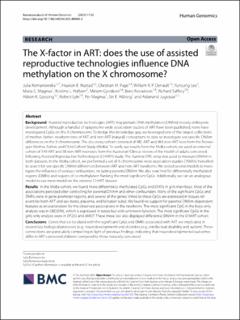| dc.contributor.author | Romanowska, Julia | |
| dc.contributor.author | Nustad, Haakon Egdetveit | |
| dc.contributor.author | Page, Christian Magnus | |
| dc.contributor.author | Denault, William Robert Paul | |
| dc.contributor.author | Lee, Yunsung | |
| dc.contributor.author | Magnus, Maria Christine | |
| dc.contributor.author | Haftorn, Kristine Løkås | |
| dc.contributor.author | Gjerdevik, Miriam | |
| dc.contributor.author | Novakovic, Boris | |
| dc.contributor.author | Saffery, Richard | |
| dc.contributor.author | Gjessing, Håkon K. | |
| dc.contributor.author | lyle, robert | |
| dc.contributor.author | Magnus, Per Minor | |
| dc.contributor.author | Håberg, Siri Eldevik | |
| dc.contributor.author | Jugessur, Astanand | |
| dc.date.accessioned | 2023-08-14T13:10:17Z | |
| dc.date.available | 2023-08-14T13:10:17Z | |
| dc.date.created | 2023-05-16T12:23:46Z | |
| dc.date.issued | 2023 | |
| dc.identifier.issn | 1473-9542 | |
| dc.identifier.uri | https://hdl.handle.net/11250/3083905 | |
| dc.description.abstract | Background Assisted reproductive technologies (ART) may perturb DNA methylation (DNAm) in early embryonic development. Although a handful of epigenome-wide association studies of ART have been published, none have investigated CpGs on the X chromosome. To bridge this knowledge gap, we leveraged one of the largest collections of mother–father–newborn trios of ART and non-ART (natural) conceptions to date to investigate sex-specific DNAm differences on the X chromosome. The discovery cohort consisted of 982 ART and 963 non-ART trios from the Norwegian Mother, Father, and Child Cohort Study (MoBa). To verify our results from the MoBa cohort, we used an external cohort of 149 ART and 58 non-ART neonates from the Australian ‘Clinical review of the Health of adults conceived following Assisted Reproductive Technologies’ (CHART) study. The Illumina EPIC array was used to measure DNAm in both datasets. In the MoBa cohort, we performed a set of X-chromosome-wide association studies (‘XWASs’ hereafter) to search for sex-specific DNAm differences between ART and non-ART newborns. We tested several models to investigate the influence of various confounders, including parental DNAm. We also searched for differentially methylated regions (DMRs) and regions of co-methylation flanking the most significant CpGs. Additionally, we ran an analogous model to our main model on the external CHART dataset. Results In the MoBa cohort, we found more differentially methylated CpGs and DMRs in girls than boys. Most of the associations persisted after controlling for parental DNAm and other confounders. Many of the significant CpGs and DMRs were in gene-promoter regions, and several of the genes linked to these CpGs are expressed in tissues relevant for both ART and sex (testis, placenta, and fallopian tube). We found no support for parental DNAm-dependent features as an explanation for the observed associations in the newborns. The most significant CpG in the boys-only analysis was in UBE2DNL, which is expressed in testes but with unknown function. The most significant CpGs in the girls-only analysis were in EIF2S3 and AMOT. These three loci also displayed differential DNAm in the CHART cohort. Conclusions Genes that co-localized with the significant CpGs and DMRs associated with ART are implicated in several key biological processes (e.g., neurodevelopment) and disorders (e.g., intellectual disability and autism). These connections are particularly compelling in light of previous findings indicating that neurodevelopmental outcomes differ in ART-conceived children compared to those naturally conceived. | en_US |
| dc.language.iso | eng | en_US |
| dc.publisher | BMC | en_US |
| dc.rights | Navngivelse 4.0 Internasjonal | * |
| dc.rights.uri | http://creativecommons.org/licenses/by/4.0/deed.no | * |
| dc.title | The X-factor in ART: does the use of assisted reproductive technologies influence DNA methylation on the X chromosome? | en_US |
| dc.type | Journal article | en_US |
| dc.type | Peer reviewed | en_US |
| dc.description.version | publishedVersion | en_US |
| dc.rights.holder | Copyright 2023 The Author(s) | en_US |
| dc.source.articlenumber | 35 | en_US |
| cristin.ispublished | true | |
| cristin.fulltext | original | |
| cristin.qualitycode | 1 | |
| dc.identifier.doi | 10.1186/s40246-023-00484-6 | |
| dc.identifier.cristin | 2147809 | |
| dc.source.journal | Human Genomics | en_US |
| dc.identifier.citation | Human Genomics. 2023, 17 (1), 35. | en_US |
| dc.source.volume | 17 | en_US |
| dc.source.issue | 1 | en_US |

